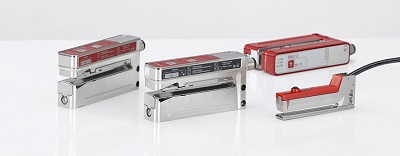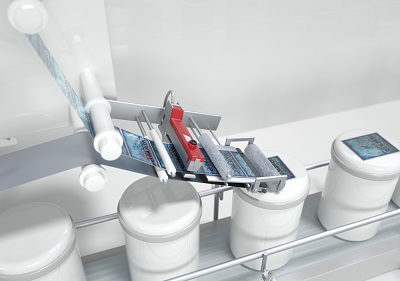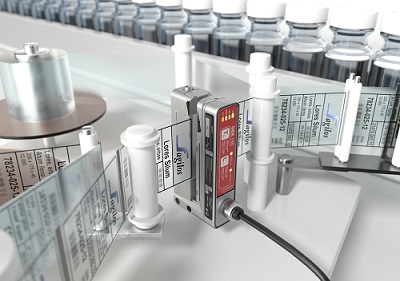text.skipToContent
text.skipToNavigation
With the new GSX combined forked sensor, Leuze is once again presenting a worldwide innovation. The device combines the advantages of light and ultrasonic sensors. The new GSX rounds of Leuze's range of forked sensors. The device is especially suitable for labeling machines used in the packaging industry.
Owen, October 2, 2020 – With the introduction of the GSX, the world's first combined forked sensor, Leuze is continuing its decades-long tradition as an innovator. Leuze invented not only the first label fork with the GS05, but also developed the first ultrasonic forked sensor with the GSU14. With the company's latest innovation, the GSX (various models available), Leuze is rounding off its forked sensor product range by adding a combined model that can do both: light and ultrasonics. It thus combines the advantages of the optical variants with those of the ultrasonic solutions, and it is best suited for the labeling machines used in the packaging industry. With this innovation, Leuze is once again demonstrating their many years of expertise and the application know-how of the Sensor People in this field.
Affixing labels of various shapes, sizes, and materials on products and packaging by means of a labeling machine is one of the fundamental tasks carried out in the packaging industry. For its precise positioning the label has to be safely and reliably detected – even at high conveyor speeds. This task is performed by forked sensors, which house the transmitter and receiver in a single device and ensure high operational safety. These devices are not only very sensitive, they are also easy to mount and do not require any alignment. Until now, Leuze offered two forked sensor models for this purpose: light and ultrasonics. A new version that combines light and ultrasonics is now available. Leuze is thus adding another world's first to their product range and rounds off their assortment.
The GSX fork sensor is the world's first sensor of its kind and combines the two detection methods of ultrasonics and light in a single housing. It brings together the advantages of both principles and can be used very flexibly. It reliably, quickly, and precisely detects a wide range of labels, regardless of their material and surface characteristics. This increases the machine throughput and avoids downtime. Even labels made of inhomogeneous cavitated BOPP material can be reliably detected through the optical operating principle. The forked sensor is especially well suited for applications in which various types of labels need to be detected. Until now, this often required several different forked sensors. The user saves not only space, but also additional time and costs of installation. The new forked sensor can be quickly and easily set up via the teach button in order to teach the label-carrier combination. Only one universal mounting position is required for all objects.
The new GSX forked sensor features an IO-Link interface. This serves to easily, quickly, and economically configure the sensor. The interface can be used to enable remote teaching, or to lock the buttons, among other things. In addition, recipe management facilitates easy format changeovers when replacing rolls. This means that re-teaching is not necessary when changing rolls to a different label format. The format is changed quickly by selecting the appropriate parameter set for the corresponding label format. This parameter selection is directly carried out on the labeling machine via the HMI. It saves not only setup time, but it also increases the production volume and makes the system more economical.

The extensive fork sensor product range with the new GSX14E combined fork sensor.

Detection of non-transparent labels on label-carrier combinations of labeling machines.

Detection with the fork from Leuze
Two in one: Leuze presents the GSX, the world's first combined forked sensor
With the new GSX combined forked sensor, Leuze is once again presenting a worldwide innovation. The device combines the advantages of light and ultrasonic sensors. The new GSX rounds of Leuze's range of forked sensors. The device is especially suitable for labeling machines used in the packaging industry.Owen, October 2, 2020 – With the introduction of the GSX, the world's first combined forked sensor, Leuze is continuing its decades-long tradition as an innovator. Leuze invented not only the first label fork with the GS05, but also developed the first ultrasonic forked sensor with the GSU14. With the company's latest innovation, the GSX (various models available), Leuze is rounding off its forked sensor product range by adding a combined model that can do both: light and ultrasonics. It thus combines the advantages of the optical variants with those of the ultrasonic solutions, and it is best suited for the labeling machines used in the packaging industry. With this innovation, Leuze is once again demonstrating their many years of expertise and the application know-how of the Sensor People in this field.
Leuze expands its forked sensor product range
Affixing labels of various shapes, sizes, and materials on products and packaging by means of a labeling machine is one of the fundamental tasks carried out in the packaging industry. For its precise positioning the label has to be safely and reliably detected – even at high conveyor speeds. This task is performed by forked sensors, which house the transmitter and receiver in a single device and ensure high operational safety. These devices are not only very sensitive, they are also easy to mount and do not require any alignment. Until now, Leuze offered two forked sensor models for this purpose: light and ultrasonics. A new version that combines light and ultrasonics is now available. Leuze is thus adding another world's first to their product range and rounds off their assortment.
Two in one: world's first GSX14E
The GSX fork sensor is the world's first sensor of its kind and combines the two detection methods of ultrasonics and light in a single housing. It brings together the advantages of both principles and can be used very flexibly. It reliably, quickly, and precisely detects a wide range of labels, regardless of their material and surface characteristics. This increases the machine throughput and avoids downtime. Even labels made of inhomogeneous cavitated BOPP material can be reliably detected through the optical operating principle. The forked sensor is especially well suited for applications in which various types of labels need to be detected. Until now, this often required several different forked sensors. The user saves not only space, but also additional time and costs of installation. The new forked sensor can be quickly and easily set up via the teach button in order to teach the label-carrier combination. Only one universal mounting position is required for all objects.
IO-Link for easy configuration and recipe management
The new GSX forked sensor features an IO-Link interface. This serves to easily, quickly, and economically configure the sensor. The interface can be used to enable remote teaching, or to lock the buttons, among other things. In addition, recipe management facilitates easy format changeovers when replacing rolls. This means that re-teaching is not necessary when changing rolls to a different label format. The format is changed quickly by selecting the appropriate parameter set for the corresponding label format. This parameter selection is directly carried out on the labeling machine via the HMI. It saves not only setup time, but it also increases the production volume and makes the system more economical.The extensive fork sensor product range with the new GSX14E combined fork sensor.
Detection of non-transparent labels on label-carrier combinations of labeling machines.
Detection of transparent or semi-transparent labels on label-carrier combinations of labeling machines.
You might also be interested in this:
Leuze ODS 110
Read further
With our expanded line of distance sensors, you can choose from a large selection of different designs with especially large operating ranges and multiple switching points. “With us, you always find the right solution for your pallet warehouse applications, such as for compartment occupation checks, push-through protection or collision protection.”
Leuze DRT 25C
Read further
The DRT 25C dynamic reference diffuse sensor – an innovative new product from Leuze – is specially designed for the detection of confectionery and baked goods. Thanks to intelligent CAT technology it reliably recognizes flat and spherical products, transparent to high-gloss foils as well as irregular shapes and contours.
Schneider Electric XIOT
Read further
The Internet of Things: IoT, is the extension of the Internet to connected devices. Telemecanique Sensors offers a wireless solution to collect data from remote equipment and use this data, via the Internet, on a PC or mobile device. The XIOT Cloud connected switch from Telemecanique Sensors is based on LPWAN: low power wide area network, technology, operated by Sigfox. The Sigfox network covers 32 countries and is already very extensive in Europe. It is also being rapidly deployed in the US and Asia-Pacific. It uses antennas with a range of around 50 km. The map on the Sigfox website shows exactly which areas are covered by the Network.
Pilz PSENOpt II
Read further
The second generation of light curtains, PSENopt II, provide safe access to the production process and provide finger, hand and body protection, depending on the requirement. The first Type 3 safety light curtains are specifically designed for applications up to PL d of EN/IEC 61496-1. Type 4 light curtains are also available for applications up to PL e in accordance with EN/IEC 61496-1/-2. As the units are so robust, PSENopt II sensors provide protection against shock, collision and vibration and so are suitable for use in rugged industrial environments. The operator can evaluate the essential causes and system defects responsible for the machine stop by means of the LEDs. Downtimes are reduced as a result.
